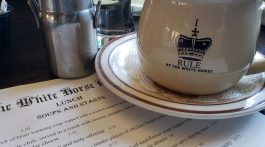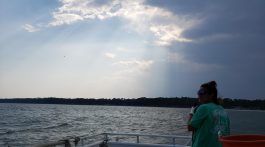Connecticut has a state fish! The American Shad was once so important to coastal life that it was named our state fish in 2003. It was a crucial source of food for Native Americans and New World colonists and then an important commercial fishery for the Connecticut and other rivers in our state.
The Shad is a member of the herring family. It spawns in fresh water, migrates to the ocean to live in schools for 3 to 6 years and then returns to the same river to fight its way upstream and lay eggs for the next generation – just like salmon. Adult Shad weigh from 3 to 8 pounds and in northern waters, return to the ocean after spawning.
The Shad run is triggered by warming waters. It usually starts in late April and runs on into May. This year’s run may be late – it’s been a cold spring so far. Shad actually spawn in rivers up and down the east coast, starting in the St. Johns River in Florida (where they can go as far as 375 miles inland) to New England. North of there, water temperatures never hit the mark.
In their heyday, hundreds of thousands of Shad swarmed up the Connecticut River every spring. This bounty could be scooped out of the river in spring when fresh food was scarce. Native Americans relied on Shad as a food source and showed settlers how to get in on the abundance. Later, Shad was an important commercial fishery supplying hungry cities up and down the coast. Known as a poor man’s food, it was plentiful and cheap. (Lobster also fell into this category in some areas.)
Shad has evolved from important food source to a seasonal tradition and now an occasional delicacy. The Shad fishery, like so many others, is declining. The problems began long ago with the damming of rivers for industrial power, blocking access to the headwaters for the spawning Shad. Many rivers, like the Merrimack in New Hampshire, were empty of Shad as early as 1888. The Connecticut, with a long un-dammed run, has been the most productive Shad river in New England. Recently, the catch has been dropping in a “chicken and egg” scenario of declining demand and decreased fishing – each feeding the other. Both consumers and rivermen are aging out of this tradition, and for reasons that are not clear, the next generation doesn’t know about and enjoy the ritual of Shad in the spring. Shad used to be in the top five of Connecticut commercial fisheries, but is now largely recreational.
Shad are bony and difficult to fillet – another old-time skill that is declining. Baking whole fish until the the bones dissolved was one old-time way around this problem, but it didn’t make for very good eating. Al Pagano of Pagano’s Seafood on Water Street guessed that there might be only two skilled Shad filleters (pronounced like billet) in the New York fish market. Tom Savoy of the Connecticut Division of Marine Fisheries thought there might be less that six in the state. It’s much easier to harvest the roe and leave the fish whole for other purposes.
Shad Roe, the eggs of the shad, are prized as a seasonal delicacy. Sauteed in butter and often served with crisp bacon, they are the culinary trophy of the Shad season. My birthday falls in the Connecticut Shad season, and sauteed shad roe has been on the celebration menu for years – a tradition introduced by my father. In 2010, at the legendary French Laundry restaurant in the Napa Valley, Shad Roe was one course on our multi-occasion celebratory tasting menu as a nod to its place in our family’s culinary custom. .
Despite its decline in popularity, Shad is still a cause for celebration along the Connecticut River. In Windsor, just north of Hartford, the annual Shad Derby runs from late April to Mid May. There are some fishing contests and clinics, but with the decline of Shad, the festival has expanded to include a 5K road race, parade (featuring the Shad Derby Queen), beer tasting, Gala Evening, craft festival, and a Lobster Feast. See all the offerings at www.windsorshadderby.org. Put together by the town’s service clubs, the Derby continues to draw people to the Connecticut River shore to celebrate our State Fish.
Locally Shad is available at Pagano’s Seafood on Water Street in Norwalk. Proprietor Al Pagano says he’s getting supplies from Virginia now, but the Connecticut River Shad, which are the top quality of the season, should be arriving soon. Although he doesn’t sell as much as in the past, it’s still an important marker of the changing seasons for Pagano and his customers. Connecticut River Shad fishermen are looking for a strong spring flood this year from the substantial New England snow pack upstream. A heavy flow and strong current makes upstream journey more difficult and the fishing harder, possibly reducing the catch.
Recently, I lamented Connecticut’s lack of a state cookie. I’m proud that we have a state fish. Shad fed the state for many years and was a rich source of income for Connecticut rivermen. I hope the fishery rebounds and Shad returns to its significant place in our Connecticut culture. In the meantime, I’m looking forward to my birthday dinner.












No Comment